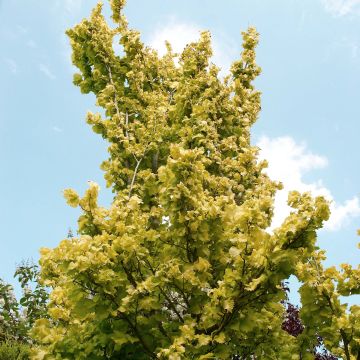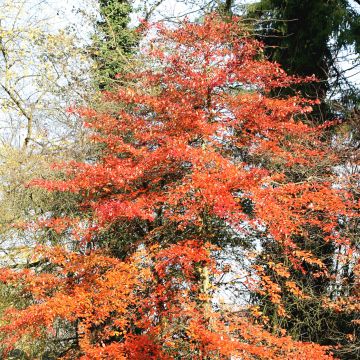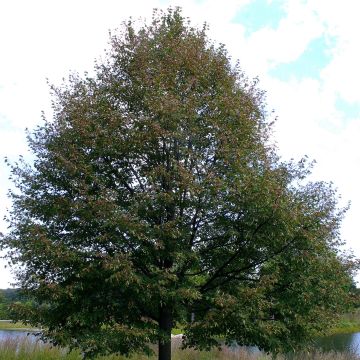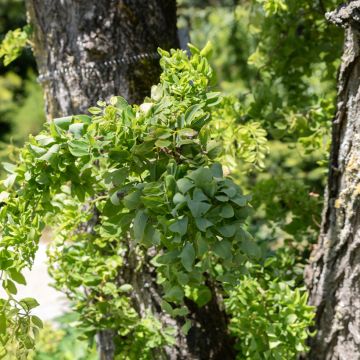

Ulmus minor Webbiana - Elm
Ulmus minor Webbiana - Elm
Ulmus minor Webbiana
Field Elm, Smooth-leaved Elm, Common Elm
Special offer!
Receive a €20 voucher for any order over €90 (excluding delivery costs, credit notes, and plastic-free options)!
1- Add your favorite plants to your cart.
2- Once you have reached €90, confirm your order (you can even choose the delivery date!).
3- As soon as your order is shipped, you will receive an email containing your voucher code, valid for 3 months (90 days).
Your voucher is unique and can only be used once, for any order with a minimum value of €20, excluding delivery costs.
Can be combined with other current offers, non-divisible and non-refundable.
Home or relay delivery (depending on size and destination)
Schedule delivery date,
and select date in basket
This plant carries a 24 months recovery warranty
More information
We guarantee the quality of our plants for a full growing cycle, and will replace at our expense any plant that fails to recover under normal climatic and planting conditions.
Would this plant suit my garden?
Set up your Plantfit profile →
Description
Ulmus minor 'Webbiana', also known as Webb's Curly-Leaved Elm, is an unusual cultivar of field elm and is rarely planted in gardens. Its unique leaves, pyramidal habit, and tall stature make it a standout in a park or large garden. Although it is not resistant to Dutch elm disease, this cultivar is sought after by collectors for its ornamental value. Perfectly adapted to our climates, very hardy, and tolerant of a wide range of neutral to alkaline soils, including heavy, chalky, and slightly dry soils.
Ulmus minor 'Webbiana' belongs to the Ulmaceae family. This tree was discovered in London, in Lee's Nursery, around 1868. This cultivar of field elm is characterised by short, rounded leaves, dark green on the upper side and whitish green underneath, folding longitudinally in a "frizzy" manner. Its habit is pyramidal with ascending branches, and its deciduous foliage is relatively sparse. The tree is female and produces fruits. Its subtle flowering occurs in March-April, before the leaves appear in the form of clusters of small red flowers that develop on two-year-old branches. The flowers are followed, in the presence of a male subject nearby, by bi-coloured winged fruits, light red in the centre and lime-green on the edges. The trunk is covered with a rough bark typical of elms. This cultivar was distributed in the trade in the late 19th and early 20th centuries, notably by the Späth nurseries in Berlin and Louis van Houtte in Ghent.
The species, Ulmus minor (syn. Ulmus campestris), is native to a vast area covering Europe, Asia Minor, and North Africa. It is a member of the Ulmaceae family. Nowadays, the Field Elm can still be found here and there, in the form of coppices, regularly cut back due to the disease. A few rare individuals seem to escape Dutch elm disease, and the species also persists in the form of attractive horticultural varieties with reduced growth. Thriving in neutral to chalky soils, this tree appreciates a certain dampness, but can tolerate drier conditions when deeply rooted.
This 'Webbiana' Elm is suitable for large estates and parks due to its significant growth. It will be enhanced by the presence of purple-leaved trees such as Acer platanoides Crimson King, a large Norway Maple with almost black foliage, or the Purple Beech (Fagus sylvatica Atropurpurea). In a park, it can be accompanied by native species such as Quercus robur (English oak), Carpinus betulus (European hornbeam), Tilia cordata (small-leaved lime), and Acer campestre (field maple).
Plant habit
Flowering
Foliage
Botanical data
Ulmus
minor
Webbiana
Ulmaceae
Field Elm, Smooth-leaved Elm, Common Elm
Ulmus 'Webbiana'
Cultivar or hybrid
Other Ulmus - Elm
View all →Planting and care
Ulmus minor 'Webbiana' is best planted in autumn in ordinary soil, even heavy or chalky soil. While it grows faster in moist soil, it adapts well to drier soil once it is well rooted. Plant it in a clear sunny or semi-shaded location. This tree adapts to almost all climates, but it does not like acidic soil. Water and mulch it in the early summers to help it establish. Prune in winter to balance its branches if necessary, and during the season to remove branches with "normal" leaves, which can occur in some varieties.
In the 70s, an epidemic of Dutch elm disease greatly reduced the population of Elms in Europe. Following this event, a monitoring program was implemented. The disease is a fungal disease that is transmitted by a bark beetle. The first symptoms appear on a branch of the canopy and are characterised by wilting and folding of the leaves during the growing season. Generally, the bark beetles invade large specimens exceeding 2m in height. Only organic solutions remain effective, such as pheromone traps or the introduction of bark beetle predators.
Planting period
Intended location
Care
Planting & care advice
This item has not been reviewed yet - be the first to leave a review about it.
Similar products
Haven't found what you were looking for?
Hardiness is the lowest winter temperature a plant can endure without suffering serious damage or even dying. However, hardiness is affected by location (a sheltered area, such as a patio), protection (winter cover) and soil type (hardiness is improved by well-drained soil).

Photo Sharing Terms & Conditions
In order to encourage gardeners to interact and share their experiences, Promesse de fleurs offers various media enabling content to be uploaded onto its Site - in particular via the ‘Photo sharing’ module.
The User agrees to refrain from:
- Posting any content that is illegal, prejudicial, insulting, racist, inciteful to hatred, revisionist, contrary to public decency, that infringes on privacy or on the privacy rights of third parties, in particular the publicity rights of persons and goods, intellectual property rights, or the right to privacy.
- Submitting content on behalf of a third party;
- Impersonate the identity of a third party and/or publish any personal information about a third party;
In general, the User undertakes to refrain from any unethical behaviour.
All Content (in particular text, comments, files, images, photos, videos, creative works, etc.), which may be subject to property or intellectual property rights, image or other private rights, shall remain the property of the User, subject to the limited rights granted by the terms of the licence granted by Promesse de fleurs as stated below. Users are at liberty to publish or not to publish such Content on the Site, notably via the ‘Photo Sharing’ facility, and accept that this Content shall be made public and freely accessible, notably on the Internet.
Users further acknowledge, undertake to have ,and guarantee that they hold all necessary rights and permissions to publish such material on the Site, in particular with regard to the legislation in force pertaining to any privacy, property, intellectual property, image, or contractual rights, or rights of any other nature. By publishing such Content on the Site, Users acknowledge accepting full liability as publishers of the Content within the meaning of the law, and grant Promesse de fleurs, free of charge, an inclusive, worldwide licence for the said Content for the entire duration of its publication, including all reproduction, representation, up/downloading, displaying, performing, transmission, and storage rights.
Users also grant permission for their name to be linked to the Content and accept that this link may not always be made available.
By engaging in posting material, Users consent to their Content becoming automatically accessible on the Internet, in particular on other sites and/or blogs and/or web pages of the Promesse de fleurs site, including in particular social pages and the Promesse de fleurs catalogue.
Users may secure the removal of entrusted content free of charge by issuing a simple request via our contact form.
The flowering period indicated on our website applies to countries and regions located in USDA zone 8 (France, the United Kingdom, Ireland, the Netherlands, etc.)
It will vary according to where you live:
- In zones 9 to 10 (Italy, Spain, Greece, etc.), flowering will occur about 2 to 4 weeks earlier.
- In zones 6 to 7 (Germany, Poland, Slovenia, and lower mountainous regions), flowering will be delayed by 2 to 3 weeks.
- In zone 5 (Central Europe, Scandinavia), blooming will be delayed by 3 to 5 weeks.
In temperate climates, pruning of spring-flowering shrubs (forsythia, spireas, etc.) should be done just after flowering.
Pruning of summer-flowering shrubs (Indian Lilac, Perovskia, etc.) can be done in winter or spring.
In cold regions as well as with frost-sensitive plants, avoid pruning too early when severe frosts may still occur.
The planting period indicated on our website applies to countries and regions located in USDA zone 8 (France, United Kingdom, Ireland, Netherlands).
It will vary according to where you live:
- In Mediterranean zones (Marseille, Madrid, Milan, etc.), autumn and winter are the best planting periods.
- In continental zones (Strasbourg, Munich, Vienna, etc.), delay planting by 2 to 3 weeks in spring and bring it forward by 2 to 4 weeks in autumn.
- In mountainous regions (the Alps, Pyrenees, Carpathians, etc.), it is best to plant in late spring (May-June) or late summer (August-September).
The harvesting period indicated on our website applies to countries and regions in USDA zone 8 (France, England, Ireland, the Netherlands).
In colder areas (Scandinavia, Poland, Austria...) fruit and vegetable harvests are likely to be delayed by 3-4 weeks.
In warmer areas (Italy, Spain, Greece, etc.), harvesting will probably take place earlier, depending on weather conditions.
The sowing periods indicated on our website apply to countries and regions within USDA Zone 8 (France, UK, Ireland, Netherlands).
In colder areas (Scandinavia, Poland, Austria...), delay any outdoor sowing by 3-4 weeks, or sow under glass.
In warmer climes (Italy, Spain, Greece, etc.), bring outdoor sowing forward by a few weeks.

























































